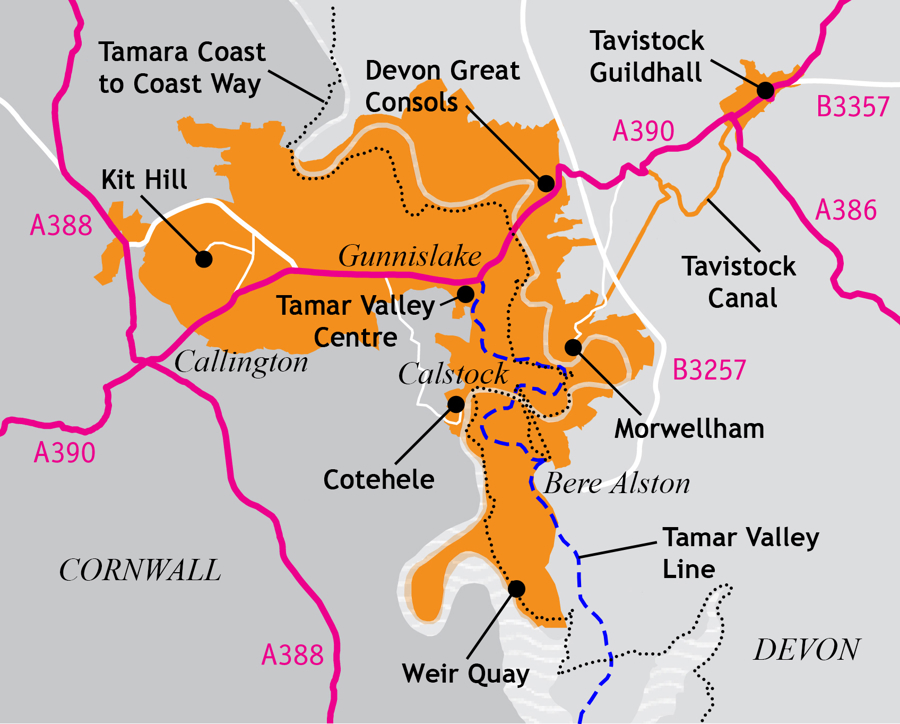Visit - A10 Tamar Valley Mining District with Tavistock
A10 Tamar Valley Mining District with Tavistock - Nans Tamar & Tavistock
Nature and industry entwined
Set in a National Landscape (a designated Area of Outstanding Natural Beauty), the Tamar Valley encompasses a breathtaking landscape that is as diverse as it is historically important. Stretching from the high granite ridge and exposed moors of Kit Hill in Cornwall to the lush, deep wooded valleys of the meandering River Tamar – and the farming lands of the Devon plateau beyond – the Area spans the border between Cornwall and Devon Tavistock itself is unlike any other town within the Cornish Mining World Heritage Site. The dramatic remodelling of much of the medieval town by the 7th Duke of Bedford during the mid-19th century was achieved with profits from his mines.
‘In today’s tranquillity it’s hard to imagine the noise from over 100 mines that operated at the height of its mining boom’.
Places to visit
The Tavistock Guildhall Heritage Centre is a Key Centre within the UNESCO Cornwall & West Devon Mining Landscape World Heritage Site operated by Tavistock Town Council in partnership with Tavistock Heritage Trust.
Visitors can learn how 19th century mining transformed Tavistock - once home to one of the largest copper and arsenic mines in the world via the building’s new interpretation centre.
The building is also home to the town’s Visitor Information Centre and a stunning Victorian courtroom which has been restored and converted into a unique events venue.
A fascinating exploration of Blanchdown Wood, on the east side of the Tamar Valley, and the extensive remains of Devon Great Consols, via pleasant paths and tracks.
This circular walk explores the mines of Devon Great Consols, at one time the largest copper supplier in Europe. Following the discovery of a 3-mile (4.8km) long copper lode – the largest in the southwest – in 1844, these steep slopes upriver from Gunnislake were the site of intensive mining activity, eventually stretching over 140 acres. When copper prices fell, the mine switched to producing vast quantities of arsenic; it was said that enough arsenic was stored at Morwellham Quay ‘to poison the entire world’. The mine went bankrupt in 1901, with arsenic production seeing a brief revival from 1915 into the 1920s. The area is now home to a complex network of signed multi-use trails and unsigned paths.
Set in the heart of the Tamar Valley National Landscape, the Tamar Valley Centre provides inspiration to visitors and is a wonderful resource for the community. It also offers a fantastic space for corporate meetings, workshops, regular leisure groups and exhibitions.
The Tamar Valley Mining District with Tavistock is Area A10 of the World Heritage Site and there is so much to see and do. This Area is also part of the beautiful Tamar Valley National Landscape, where today it’s hard to imagine the noise from over 100 mines that operated in the area at the height of its mining boom.
There is also lots to discover in the nearby historic market town of Tavistock, the core of which was transformed by the 7th Duke of Bedford during the mid-19th century and achieved with profits from his mines.
Here are some ideas for your visit:
The beautiful Tamar Valley Line runs through the heart of this part of the World Heritage Site and the TVNL. There is much to enjoy from the comfort of the train as you wind your way up through this once bustling mining landscape - https://greatscenicrailways.co.uk/lines/tamar-valley-line/
Hop off the train at Bere Alston and look out for the information panel on the station building outlining a walk exploring the mining heritage of this part of the Tamar Valley. There is a choice of two walks, a shorter circular route of 5¼ miles and a longer linear 6¾ mile walk to Bere Ferrers where you can pick up the train for your return journey.
Alight at Calstock and explore this fascinating riverside village, once one of a number of busy ports and quays along this stretch of the River Tamar. These served numerous local mines whose remains are hidden amongst the lush treescape that covers much of the valley today. A circular walk from Calstock taking in Okel Tor is a good place to start - https://visittamarvalley.co.uk/short_walk/calstock-station-to-okel-tor-mine-and-the-tamar-circular-walk
You can also check out Visit Tamar Valley’s Railway Rambles page for more walks from stations in the Tamar Valley - https://visittamarvalley.co.uk/railway-rambles-walks-from-local-train-stations
If you want to explore further afield, stay on the train to Gunnislake and then catch the 79 bus in the direction of Tavistock and request to stop at the entrance to the Tamar Trails Centre. From here you can enjoy a network of multi-use trails that take you through the heart of the mining landscape and you can discover the history of the former Devon Great Consols mine - https://www.tamartrails.co.uk/. Don’t forget to download the map before you go and to check out the audio clips about the site - https://www.tamartrails.co.uk/maps/
To explore the mining connections in the beautiful town of Tavistock, you have a number of options to get there by bus and train*. When you arrive, head to Tavistock Guildhall and Tavistock Information Centre to discover what the town has to offer and don’t miss a visit to Tavistock Museum. All are housed within the town’s Heritage Quarter.
*From Plymouth station head to Royal Parade to catch the Number 1 bus to Tavistock - https://www.stagecoachbus.com/routes/south-west/1/plymouth-sherford-tavistock-george-p-r/xdbo001.o
Travel by train to Gunnislake on the Tamar Valley Line and then catch the 79 bus to Tavistock from opposite the station. https://www.transportforcornwall.co.uk/
If you are heading from Exeter and beyond you can hop on the train to Okehampton and then take the 118 Rail Link bus from the station directly to Tavistock - https://www.cartogold.co.uk/Devon/timetables/118_Okehampton-Tavistock.pdf
For train times - https://www.gwr.com/
For bus times in Cornwall - https://www.transportforcornwall.co.uk/
